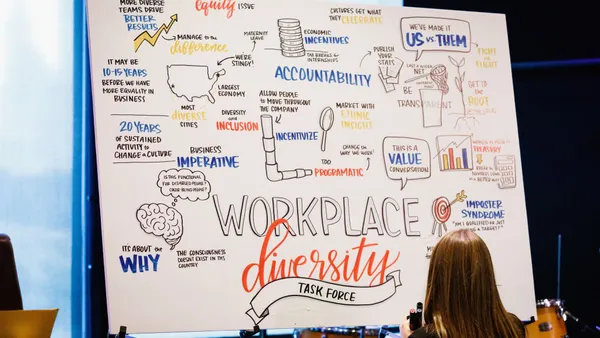What is workplace diversity and inclusion?
Diversity in the workplace means the workforce consists of individuals from different races, ethnicities, genders, ages, and educational, socio-economic, religious, or cultural backgrounds. Diversity is the "what" and focuses on the makeup of your workforce.
Inclusion is the “how." As in, how are your employees treated while they are at work? An inclusive culture is one where employees are not afraid to be their authentic selves. They have a sense of belonging, feel comfortable voicing their opinions and see themselves reflected in your company values.
It does no good to have a diverse workforce unless your workplace is inclusive.
For a deeper dive into the definition of diversity, check out this web page "What is Diversity?"
The benefits of a diverse and inclusive workplace
Diversity and inclusion are essential for your organization’s long-term success. Employees that feel valued and accepted are more engaged, higher producing, and stay longer, resulting in lower turnover and better business outcomes that continue compounding over time.
Diverse workforces are higher performing and more innovative because they bring diverse talent, skills, experiences, and perspectives to the work. When you combine this with an inclusive workforce where employees are not afraid to engage, be creative, problem-solve, innovate, and speak up, you see engagement rise and the value of the employer brand increase. This pays off ten-fold in attracting a wider pool of talent, enabling managers to hire the highest quality employees, and leading to better hires. You get the picture.
"Companies with greater gender, ethnic and cultural diversity were 36% more likely to experience above-average profitability compared to their counterparts."
(source: McKinsey & Company)
Improving organizational diversity and inclusion
Improving diversity and inclusion in the workplace comes down to changing your organizational culture, not just hiring different types of employees. Diversity in the workplace is not just about the numbers. Hiring a diverse staff is a start, but the real work comes from creating a climate that promotes acceptance and embraces employees' differences. Once you’ve started improving your diversity efforts, you’ll need to support your employees by creating an inclusive culture.
It is critical to get buy-in from your leadership at the start of this process. Organizational leaders must be committed to diversifying their workforce and creating an inclusive work environment for the long haul. They must model appropriate behaviors and enforce adherence to the program. It is demoralizing for employees to be told one thing but then notice a lack of commitment and follow-thru from leadership in daily life. In fact, this will erase any efforts and likely leave the organization in a worse spot than when the diversity and inclusion plan was initiated.
10 initiatives to improve diversity and inclusion
By implementing even a few of these diversity and inclusion initiatives, you’ll gain a competitive edge in talent acquisition and retention.
1. Awareness and Acknowledgement
The first step is to take an honest inventory of your organization and recognize a lack of diversity and inclusion. To change things, you must be aware that the problem exists in the first place and then acknowledge the need for change. Talk to your employees about diversity, equity and inclusion so you can better understand and create a plan to meet their individual needs.
2. Accept and value all differences
Recognize and value the abilities of all employees regardless of differences. An easy way to show employees you appreciate them daily is by simply engaging in a conversation and listening to them. Get to know your employees on a personal basis. When employees feel valued and accepted, they will go above and beyond.
3. Change your language
Make it clear to employees and candidates that your company values diversity and focuses on creating a diverse workforce and an inclusive workplace. Communicate your diversity and inclusion goals everywhere, including employee manuals, employment contracts, hiring, and onboarding materials and other company documents.
4. Establish diversity policies.
Diversity and inclusion policies come in all shapes and sizes. Must-haves include gender, sexual harassment, mobility, disabilities, race, religion, and sexual orientation. Here’s an example of a Diversity, Equity and Inclusion Policy from SHRM.
5. Pay attention to pay equity
Pay attention to pay equity when you determine compensation, promotions, or raises—address pay disparity. Don’t ask for salary history, as doing so can perpetuate wage gaps, enabling them to grow over time.
For more information about pay disparity, read our article, “All Things Being Equal – Navigating the Pay Equity Landscape.”
6. Hiring through referrals.
Referrals can be a great way to attract diverse candidates. If you have a diverse workforce, encourage your current employees to recruit their friends. Communicate your goals to hire a more diverse workforce for employees. Research shows that referrals are a great source of hires.
For more information on the benefits of an employee referral program, click here to read “The Value of an Employee Referral Program.”
7. Meetings
Restructure meetings to include a diverse group of participants. By being intentional with your invitations, you can ensure a wide range of voices gets heard. Examine attendee lists from past meetings to see who was/wasn’t invited. Start distributing agenda and discussion points before your meetings. Make sure all attendees are allowed to speak during meetings.
8. Develop Diversity & Inclusion Training Programs
Provide diversity and inclusion training for all levels of your organization, starting at the top. It’s important to have buy-in from your leadership – start by asking them to help develop your training curriculum.
Training should include increasing awareness of unconscious bias and reducing bias that can negatively influence management practices. Consider making diversity training a voluntary activity. Just be sure it’s widely available and widely promoted across your organization.
9. Establish an employee-led D&I committee
Create an employee-led resource group focused on improving diversity and inclusion policies and practices in your workplace. Providing a supportive and accepting environment will encourage employee engagement and collaboration.
10. Institute flexible working arrangements
Create a flexible leave policy. Offer flexible holiday time off so employees can celebrate holidays and events that are important to them. Some employers set a number of paid holiday hours instead of sticking to pre-determined holidays. You can also celebrate holidays and events for underrepresented groups like Black History Month, Juneteenth, and Pride in the office.
In conclusion
Becoming a more diverse and inclusive workplace is a long, continual process for most organizations. Everyone takes a different path, and no one reaches their goals overnight.
Maintain your momentum for your new diversity and inclusion programs by keeping them top of mind for your leadership and team. Share your diversity and inclusion efforts and successes often and in as many places as possible, such as meetings, websites, newsletters, and onboarding materials. Communicate your progress and show how these programs are changing your organization for the better.
Keep at it. You’ll get there as long as you keep a close eye on your data and measure progress and areas for improvement as you go.
"74% of millennials believe an organization is more innovative when it fosters a culture of diversity and inclusion."
(source: 2018 Deloitte Millennial Survey)










